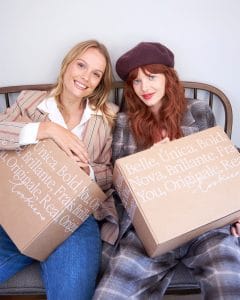Letterbox Lab provide innovative children’s science kits as subscription boxes.
The Explore Box (£8 + £2 postage) is for kids aged 6+ and contains a least an hour’s worth of fun science.
The Investigate Box (£22 + £2 postage) has more experiments and more items of collectible lab equipment with enough to keep a junior scientist busy for 3 or 4 hours.Both kits have full-colour illustrated instructions and online videos to make it easy to do all the experiments. We are trying out the Investigate Box.

The box really does fit through the letterbox!
All the equipment you need is included in the box, and you might also need some items from previous boxes.
There are eight experiments this month, plus a little bonus, exploring light and energy and how things glow.

The first experiment is using a familiar item for children, a UV pen and light.
 #
#
As well as experimenting with the glowing ink, you can also see how suncream (included) blocks UV light using UV paper.

Glow with the Flow creates glowing liquids, and demonstrates how electrons absorb energy from UV light and give it back as glowing light.

There is also an extra experiment to bounce light off the walls of the test tube, which gives a really amazing effect.

It’s also quite tricky to get a picture of it!

Photon Beam of Destruction uses a magnifying glass to burst a balloon! This is a pretty dramatic experiment, as it’s surprising how fast the balloon burst when sunlight is focused on it.
The magnifying glass itself is also used for the included bonus, a booklet for going on a bug hunt, This is a lovely thing to do when you’ve finished bursting balloons!
 use
use
Ultra Colours use UV sensitive beads.

They start out white, but change colour with UV light, either from the torch or from sunshine.

The beads look really different once they’re exposed to UV light! You use them to test how suncream and other things such as glass, block UK light.
The also make a very pretty bracelet.

Solar Photography uses sun paper to make picture, rather like a very simple photograph.

Items are put onto the blue paper and exposed to light.
Once the paper turns pale, the items are removed, and the picture is ‘set’ with water.

After setting, the exposed paper turns back to bright blue with the outlines of the items in the paler colour.
You can also see the shadows where the paper hasn’t been quite as exposed to light.

Growing cress is a popular thing with children, but this experiment demonstrates the difference between plants that are exposed to light and those that are kept in the dark. (We hvan’t finished this one yet!)

A Warm Reaction demonstrates an exothermic reaction, using calcium chloride and water. 
The final experiment uses another familiar toy – glow sticks.

This tests the effect of heat on light and energy, by putting glow sticks in cold, medium, and warm water.
You might be able to tell from the picture that the glow stick on the left is glowing the brightest, which is the one in hot water.
This box makes great use of familiar items, such as a magnifying glass and glow sticks.
The instructions as always are clear, and there plenty of information about the scientific principles behind the experiments and results.
There are plenty of opportunities for children to make their own conclusions about the results, and also to think further about what the effects might mean in a broader context.
Safety is also emphasized, with gloves and goggles included, and a safety checklist at the start of each experiment.












